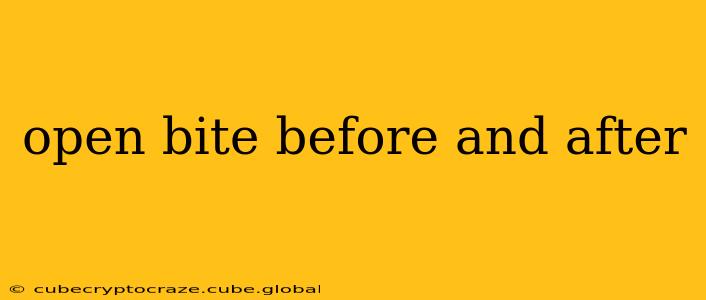An open bite is a malocclusion where the upper and lower front teeth don't overlap when the mouth is closed. This can significantly impact a person's appearance, chewing function, and even speech. Fortunately, numerous treatment options exist to correct this condition, often resulting in dramatic before-and-after transformations. This article explores the causes, treatment methods, and what you can expect from open bite correction.
What Causes an Open Bite?
Several factors can contribute to the development of an open bite. Understanding the underlying cause is crucial for determining the most effective treatment plan.
- Thumb Sucking: Prolonged thumb sucking, especially past the age of 4, is a common culprit. The constant pressure pushes the upper front teeth outwards and prevents proper closure.
- Tongue Thrusting: Habitual tongue thrusting, where the tongue pushes against the teeth, can also contribute to an open bite. This pressure forces the teeth apart.
- Genetics: Family history of malocclusion, including open bites, plays a significant role. Genetic predisposition can influence jaw growth and tooth alignment.
- Mouth Breathing: Chronic mouth breathing can affect facial growth and development, leading to an open bite.
- Certain Medical Conditions: Some medical conditions, such as craniofacial syndromes, can affect jaw development and result in an open bite.
What are the Treatment Options for an Open Bite?
The treatment approach for an open bite depends on several factors, including the severity of the malocclusion, the patient's age, and the underlying cause.
Orthodontic Treatment (Braces):
Braces are a common and effective method for correcting open bites. They gently reposition the teeth to achieve proper alignment and closure. Traditional metal braces, ceramic braces, and clear aligners (like Invisalign) can all be used. The duration of treatment varies depending on the individual case.
Orthognathic Surgery:
In more severe cases, orthognathic surgery may be necessary. This involves surgical repositioning of the jawbones to correct underlying skeletal discrepancies that contribute to the open bite. This is usually performed in conjunction with orthodontic treatment.
Myofunctional Therapy:
This therapy focuses on correcting oral habits, such as tongue thrusting and mouth breathing. It often involves exercises and techniques to retrain the muscles of the mouth and tongue. Myofunctional therapy is often used in conjunction with orthodontic treatment.
Appliances:
Depending on the severity and the cause of the open bite, various appliances may be used. These can include expanders to widen the jaw, headgear to control jaw growth, and other specialized devices.
How Long Does Open Bite Correction Take?
The treatment duration varies greatly depending on the severity of the open bite and the chosen treatment method. Orthodontic treatment with braces can typically take 12-36 months, while orthognathic surgery requires a longer period, including both pre-surgical and post-surgical orthodontic treatment. Myofunctional therapy is an ongoing process, with improvement seen over several months or years.
What is the Recovery Process Like After Open Bite Correction?
Recovery time also depends on the treatment method. After orthodontic treatment, there may be some mild discomfort and adjustments to the new bite. Orthognathic surgery involves a longer recovery period with potential swelling, bruising, and dietary restrictions. Following myofunctional therapy, patients may experience some initial discomfort as they adapt to new oral habits.
Can an Open Bite Be Corrected in Adults?
Yes, an open bite can be corrected in adults, although treatment may be more complex and time-consuming. The same treatment options as those used for children are available, but the response to treatment might differ due to the completed growth and development of the jawbones.
What are the Long-Term Effects of an Uncorrected Open Bite?
Leaving an open bite uncorrected can lead to several long-term problems, including:
- Difficulty Chewing: Proper occlusion is necessary for efficient chewing.
- Speech Problems: An open bite can affect speech clarity.
- TMJ Disorders: Temporomandibular joint disorders (TMJ) can develop due to jaw misalignment.
- Increased Risk of Tooth Decay and Gum Disease: Food particles can get trapped more easily, leading to dental problems.
- Aesthetic Concerns: An open bite can affect a person's appearance and self-confidence.
Before & After Pictures: What to Expect
Before-and-after photos of open bite correction demonstrate the dramatic improvements achievable through treatment. These often show a significant improvement in the alignment of the teeth, facial profile, and overall appearance. The specific results will vary from person to person depending on the individual case and the chosen treatment method. Remember to always consult with your orthodontist or oral surgeon for a personalized assessment and treatment plan.
This information is intended for educational purposes only and should not be considered medical advice. Always consult with a qualified dental professional for diagnosis and treatment of any dental condition.
